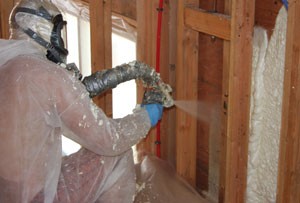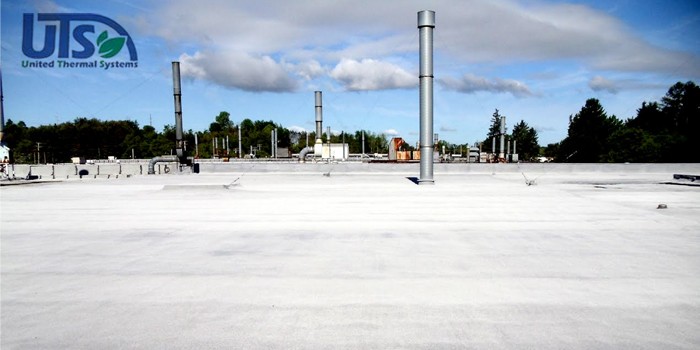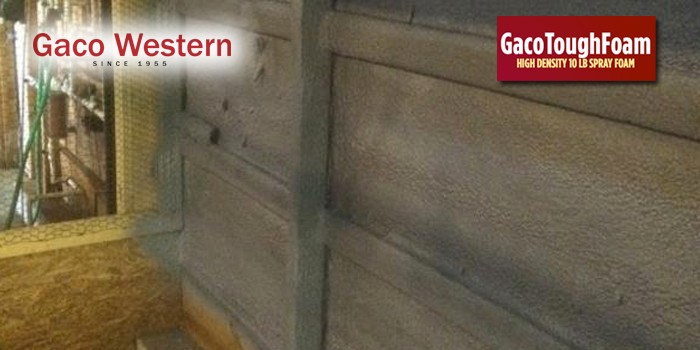How Thick Should Spray Foam Be Applied In Each Pass?

August 11, 2008 - Brielle, NJ - How thick should foam be applied in each pass? This is a question which is vital to ensuring the safety and quality of any spray foam application. Whether dealing with open or closed cell foam, roofing or wall insulation, there are certain guidelines that should be followed for suitable procedural practices.
Although various professionals may differ on specifics, there is a general consensus among experts that the best way to determine appropriate foam thickness is to follow the manufacturer’s instructions. This may seem obvious, but oftentimes guidelines provided by a manufacturer are overlooked during the application process.
Steve Shaw of Foam-Tech, a Vermont based company, points out, “The foam should be sprayed only as thick as the manufacturers recommended pass thickness. If the manufacturer does not state a maximum pass thickness you must get that information from the manufacturer. If the manufacturer can not provide this information do not use their product.”
However, due to external circumstances, it is possible that an even thinner pass thickness should be used. Shaw, who conducts spray foam training, goes on to explain, “There will be times when you will have to spray less than the recommended pass thickness due to environmental conditions. Spraying on a sun baked roof in high heat of summer may mean you have to limit your pass thickness to less than that recommended by the manufacturer.”
Mason Knowles of Mason Knowles Consulting and former executive director of the Spray Polyurethane Foam Alliance adds, “SPFA guidelines recommend no more than 1-1/2” thick lifts at a time. I believe this is a good conservative approach if the recommendations of the supplier are not known or well defined.”
It may be difficult to limit open cell foam to lifts of this thickness due to the expansion properties of open cell foam. Dave Lall, President of Demilec USA, a supplier of open cell spray foam, describes the proper application for this type of spray foam: “The minimum thickness for the first layer of the open cell spray foam should be at least three inches. This would allow the open cell foam to reach the required temperature (212º F) needed for the generation of steam to assist in the cell opening. The failure to adequately open the cells shall result in shrinkage. The subsequent layers can be reduced to at least 1 inch.” He does agree that it may be tough to gauge exact thicknesses due to the substantial expansion of open cell foam, but mentions a few variables that will affect the outcome: “The actual thickness of open cell thickness is more dependent on temperature rise during the foaming process. The heat of chemicals (machine setting), environment (substrate and air) and exotherm of chemical reaction is important to allow the temperature of the rising foam to exceed the steam point.”
Robb Miller, National Sales Manager of Lapolla Industries told us that more heat is often recommended to achieve proper results, especially for the water blown open cell systems. He indicates they commonly recommend processing their open cell foams at roughly 10-20 degrees F hotter than the closed cell systems, in the 130-140 degrees F range. This further supports the need to follow the manufacturer’s instructions, utilize highly trained applicators, and assure the spray equipment is properly set-up for the specific foam and application.
It is important to note that although a minimum temperature must be reached with open cell foam, the temperature must not exceed safe levels. Shaw states that a core temperature above 250º F will create a potentially dangerous situation. He suggests that if a foam manufacturer doesn’t provide sufficient guidelines, it is essential to conduct your own testing (in a safe and controlled environment) before applying on the job, to ensure it will not create a hazardous situation or degrade the quality of the insulation.
There are multiple reasons to adhere to these guidelines, the first being quality. Knowles mentions a few potential consequences: “If lift thickness exceeds that which is recommended by the supplier, negative results can occur including lower density, poor cell structure, cracking, splitting, or poor dimensional stability (possible shrinkage).”
Don Schumacher and Wesley Sherrer of NCFI Polyurethanes point out the concern that “some applicators will spray passes which exceed the thickness recommended by the manufacturer in an attempt to increase yields and application efficiency. The problem with this approach is that, in addition to not achieving the maximum R-values for the foam system, the other physical properties of the foam with thicker passes can degrade. Of greatest concern is the effect on dimensional stability both from the lower density and the thermal decomposition of the polymer in the foam.”
Shaw elaborates on the importance of taking environmental variables into consideration, “The application thickness has an impact on the cell structure and in place density of the foam system being sprayed. When you spray a very thin pass the foam does not generate as much heat due to the exotherm. This is due in part from the substrate absorbing some of the heat from the reaction, and also due to the fact that there is less chemical to react. Spraying a thin pass on a cold concrete wall will end up with a very high density foam. Spraying a thin pass on a hot concrete wall will end up with a lighter density foam that may be okay for a given situation. This is where trained spray foam applicators and experience pays off. Spraying the recommended pass thickness on a hot plywood roof can end up with foam that is to low in density and may have dimensional stability problems. The exothermic reaction is affected by the setup of the proportioner (heat and pressure), relative humidity, ambient temperature, altitude, barometer, chemical makeup, and substrate temperature.”
In addition to ensuring a quality application, maintaining proper pass thickness is critical to avoid potentially disastrous exothermic reactions. Knowles, a 37-year veteran in the industry, explains “If it is installed in very thick applications the exothermic heat reaction can increase to the extent where the foam begins to char and even spontaneously combust. This typically requires installation of more than 12 inches but some formulas may be as little as 6 to 8 inches.”
Shaw concurs with this point, “The heat generated by the exotherm cannot escape from the foam fast enough as it insulates itself. This causes the foam to start to char and burn, otherwise known as burnout.”
They add that even if this worst case scenario doesn’t happen, “there are still very real concerns when applying foam in passes thicker then recommended by the manufacturer caused by the rupturing of cells due to the excessive heat. Some of the performance and physical characteristics of the foam are sacrificed as cells rupture and the percentage of closed cells decreases. Some examples are: density will decrease causing loss in R-value, compressive strength will decrease causing declines in racking strength for insulation foams and durability to foot traffic for roofing foams while moisture vapor transmission will increase which can potentially cause future moisture control problems in the building assembly.”
Knowles offers another suggestion on the safest way to apply spray foam and avoid burnout, “It is also important to wait for the heat to dissipate in the foam, (usually around 10 minutes) before applying another pass of foam. Consecutive lifts of 2 inches within a few minutes of each other can lead to a similar heat build up.”
Considering exothermic reactions, there is also a significant difference between open cell and closed cell foam. However, even though open cell foam is often considered much safer in terms of exotherm, it still must be used correctly to ensure a safe application.
Knowles mentions, “I have seen low density foam that was installed with the temperature settings (preheater and hose heat) too high that developed worm holes, cracks and fissures.”
Shaw warns that both types of foam must be used with caution, “When I first started in the foam industry I was told that open cell foam would not burn out. That is simply not true as I have seen it with my own eyes. Any polyurethane foam system has the potential to self combust due to a runaway exotherm reaction. Whether this is from too thick of a pass or an improperly mixed system they all can be dangerous and sometimes even deadly.”
Dick Benthian, CEO of CPI Inc. and Director of the Foam School, both based in Barberton, OH, makes a suggestion on choosing which foam type to use, “I always recommend the more affordable open-cell foam unless there are compelling reasons to go with closed-cell foam. I deem open-cell foam perfectly suitable for all residential applications above ground. Accordingly, I would recommend closed-cell foam for basements, rooms with excessive interior moisture (such as indoor pools), or cold storage buildings.” The specific use of closed-cell over open-cell foam in these particular applications is due to the greater perm rating and its ability to resist a greater level of water/moisture intrusion and retention, which are more likely to occur in these environments.
Whether you are spraying a roof or using foam for wall insulation and whether you decide to use open cell or closed cell foam, application “pass” thickness is of critical concern for both safety and quality.
There is no substitute for proper training and application technique. Manufacturers’ directions should always be followed and proper safety precautions should be taken no matter what the situation.
Disqus website name not provided.









































